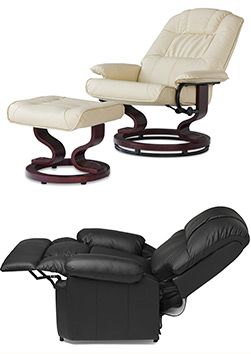It’s an age-old debate between couples - one of you wants a fresh new look in the living room while the other demands keeping the well-worn recliner. Whether you’re trying to work around an eyesore or considering adding a recliner to your space, it’s important to recognize that a recliner demands special attention and, therefore, should be integrated into a room during the planning stage of your decorating project – not after. Some things to think about…
Style
If a recliner has a simple style with no features that define or relegate it to a particular period, it likely will coordinate with most contemporary seating styles. A relaxed style of sofa, sectional or other chairs will work with it if they are of similar quality and scale. A wingback or traditional-style recliner with exposed wood arms or legs is more at home in a traditional setting. Sleek designs with track arms adapt well to modern and art deco decor. If you are in doubt about style, ask a knowledgeable consultant at an upscale furniture showroom. Often, you can customize a recliner style or select a sofa or other chair style that coordinates with an existing recliner.

Color and Pattern
Nothing pulls disparate styles together better than coordinated fabrics. If you have a recliner in good structural condition, an experienced upholsterer can recover it to coordinate with other seating or with bedding. Besides a change in color, fabric of a different texture or pattern can transform the look of a recliner. Adding details such as nail heads or contrast welting can further alter the style of the recliner to better suit your decor. If you are planning a new sofa or chair, a custom-order furniture showroom consultant can help you choose and order fabrics, including the yardage needed to recover your recliner. If you have a quality leather recliner, it may be worthwhile to recover the other seating in the room to coordinate with it.
Placement
Like all the seating in a room, a recliner should balance with the rest in a pleasing arrangement. A poor seating arrangement places the recliner in line with the sofa, all seats facing in the same direction for television viewing. Alternatively, arrange two recliners side-by-side facing the television, with a sofa or loveseat at a right angle to them. Reputable recliner manufacturers and retailers can tell you how much space to allow behind a particular recliner for it to fully recline. The amount varies, depending on the chair. The wall space, as it is often called, ranges from approximately 10 to 14 inches. Ensure no wall is behind your recliner and that it is clear of other furniture and doorways when open. Additionally, allow space for the attached ottoman piece to flip up.
Tables, Lighting and Accessories
For increased comfort and convenience near the recliner, include adequate table surface and lighting. Select a table that is sturdy and heavy enough at the bottom that the motion of the recliner will not tip it over if it is bumped. For recliners that also swivel and glide, round tables with no jutting corners work best. The recliner and another type of seating can share a table. If the table is large and stable, place a reading lamp on it; for small tables, use a floor lamp. Include a basket or box on the table to hold small items like a pen, notepad or remote control. A small throw pillow or rectangular lumbar pillow in a fabric that coordinates with the room's decor provides added comfort while further tying together your decorating scheme.